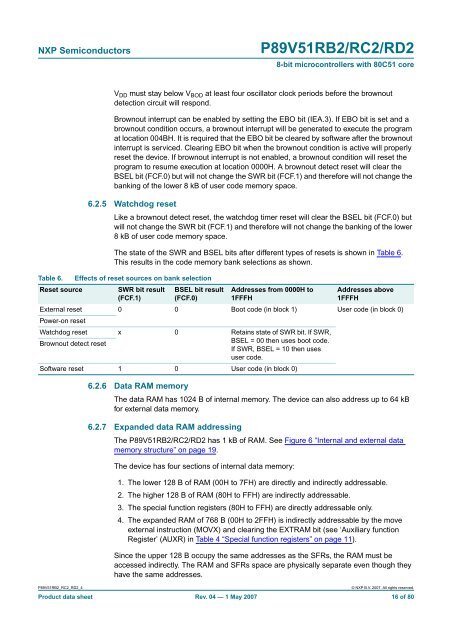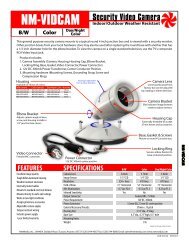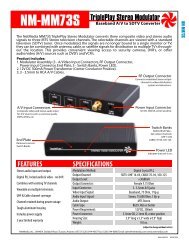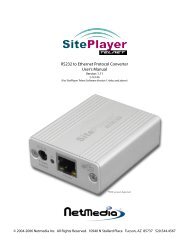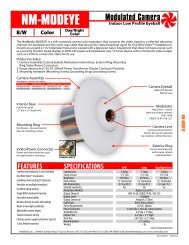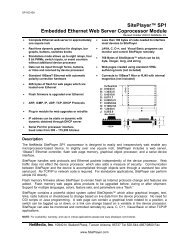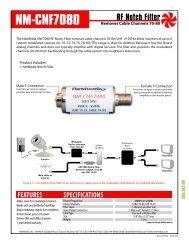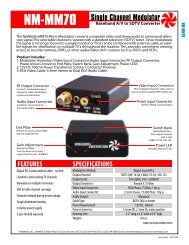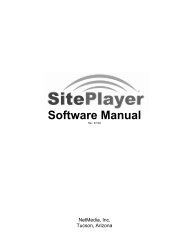P89V51RB2/RC2/RD2 8-bit 80C51 5 V low power 16/32 ... - NetMedia
P89V51RB2/RC2/RD2 8-bit 80C51 5 V low power 16/32 ... - NetMedia
P89V51RB2/RC2/RD2 8-bit 80C51 5 V low power 16/32 ... - NetMedia
You also want an ePaper? Increase the reach of your titles
YUMPU automatically turns print PDFs into web optimized ePapers that Google loves.
NXP Semiconductors<br />
<strong>P89V51RB2</strong>/<strong>RC2</strong>/<strong>RD2</strong><br />
8-<strong>bit</strong> microcontrollers with <strong>80C51</strong> core<br />
<strong>P89V51RB2</strong>_<strong>RC2</strong>_<strong>RD2</strong>_4<br />
V DD must stay be<strong>low</strong> V BOD at least four oscillator clock periods before the brownout<br />
detection circuit will respond.<br />
Brownout interrupt can be enabled by setting the EBO <strong>bit</strong> (IEA.3). If EBO <strong>bit</strong> is set and a<br />
brownout condition occurs, a brownout interrupt will be generated to execute the program<br />
at location 004BH. It is required that the EBO <strong>bit</strong> be cleared by software after the brownout<br />
interrupt is serviced. Clearing EBO <strong>bit</strong> when the brownout condition is active will properly<br />
reset the device. If brownout interrupt is not enabled, a brownout condition will reset the<br />
program to resume execution at location 0000H. A brownout detect reset will clear the<br />
BSEL <strong>bit</strong> (FCF.0) but will not change the SWR <strong>bit</strong> (FCF.1) and therefore will not change the<br />
banking of the <strong>low</strong>er 8 kB of user code memory space.<br />
6.2.5 Watchdog reset<br />
Like a brownout detect reset, the watchdog timer reset will clear the BSEL <strong>bit</strong> (FCF.0) but<br />
will not change the SWR <strong>bit</strong> (FCF.1) and therefore will not change the banking of the <strong>low</strong>er<br />
8 kB of user code memory space.<br />
The state of the SWR and BSEL <strong>bit</strong>s after different types of resets is shown in Table 6.<br />
This results in the code memory bank selections as shown.<br />
Table 6. Effects of reset sources on bank selection<br />
Reset source<br />
SWR <strong>bit</strong> result<br />
(FCF.1)<br />
BSEL <strong>bit</strong> result<br />
(FCF.0)<br />
6.2.6 Data RAM memory<br />
The data RAM has 1024 B of internal memory. The device can also address up to 64 kB<br />
for external data memory.<br />
6.2.7 Expanded data RAM addressing<br />
Addresses from 0000H to<br />
1FFFH<br />
The <strong>P89V51RB2</strong>/<strong>RC2</strong>/<strong>RD2</strong> has 1 kB of RAM. See Figure 6 “Internal and external data<br />
memory structure” on page 19.<br />
The device has four sections of internal data memory:<br />
Addresses above<br />
1FFFH<br />
External reset 0 0 Boot code (in block 1) User code (in block 0)<br />
Power-on reset<br />
Watchdog reset x 0 Retains state of SWR <strong>bit</strong>. If SWR,<br />
Brownout detect reset<br />
BSEL = 00 then uses boot code.<br />
If SWR, BSEL = 10 then uses<br />
user code.<br />
Software reset 1 0 User code (in block 0)<br />
1. The <strong>low</strong>er 128 B of RAM (00H to 7FH) are directly and indirectly addressable.<br />
2. The higher 128 B of RAM (80H to FFH) are indirectly addressable.<br />
3. The special function registers (80H to FFH) are directly addressable only.<br />
4. The expanded RAM of 768 B (00H to 2FFH) is indirectly addressable by the move<br />
external instruction (MOVX) and clearing the EXTRAM <strong>bit</strong> (see ‘Auxiliary function<br />
Register’ (AUXR) in Table 4 “Special function registers” on page 11).<br />
Since the upper 128 B occupy the same addresses as the SFRs, the RAM must be<br />
accessed indirectly. The RAM and SFRs space are physically separate even though they<br />
have the same addresses.<br />
© NXP B.V. 2007. All rights reserved.<br />
Product data sheet Rev. 04 — 1 May 2007 <strong>16</strong> of 80


